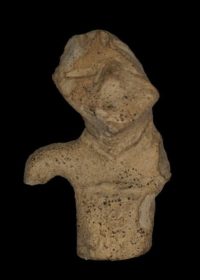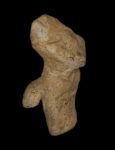 Archaeologist Piotr Alagierski was enjoying his vacation, taking a leisurely Sunday stroll through a farmed field in the southeastern Poland village of Kosina when he came across a small clay figurine. Just seven centimeters (2.8 inches) long, the little man was missing some of his parts. Only his head, torso and one arm or hand remain. What was left of him was enough for Alagierski to conclude that the fired clay piece is a Neolithic figurine that may be as much as 7,000 years old.
Archaeologist Piotr Alagierski was enjoying his vacation, taking a leisurely Sunday stroll through a farmed field in the southeastern Poland village of Kosina when he came across a small clay figurine. Just seven centimeters (2.8 inches) long, the little man was missing some of his parts. Only his head, torso and one arm or hand remain. What was left of him was enough for Alagierski to conclude that the fired clay piece is a Neolithic figurine that may be as much as 7,000 years old.
If that age is confirmed, it will make the figurine one of the oldest depictions of a human ever found in Poland and an object of national significance. Even among the few pieces from this period that have been found, he is extremely rare. The others have the voluptuous bodies and exaggerated sex characteristics frequently seen in prehistoric mother figures. All the detail in these types of figures tends to be centered on the breasts, belly and genitalia, not on facial features or adornments. The Kosina figurine takes a different approach.
“The style in which the figurine was made is surprising. It resembles similar figurines from Slovakia and Romania” – explained [Piotr Alagierski]. […]
“It is different in this case. The details of the head are clearly modelled – the hair, the nose, the chin are visible. There is a visible indentation on the chest, probably representing a garment, probably a tunic. A necklace is visible on the neck” – the archaeologist described. Contrary to the few figurines from this period previously found in Poland, this one does not have prominent sex features.
“In the field around the figurine I also noticed large quantities of fragments of ceramic vessels and obsidian, volcanic glass, which is produced by the instantaneous cooling of the lava. This material is also known from the areas of Poland’s neighboring countries: Ukraine and Slovakia” – Alagierski described in an interview with PAP.
 Alagierski believes the area where the figurine was found was an agricultural settlement founded by some of the first farmers to make a living from the land in what is now Poland. That’s what he’s basing the date of the figurine on — that there was a farm on the site from early in the shift to agriculture, and that the figurine is contemporaneous with said settlement — which seems tenuous to me so early in the investigation.
Alagierski believes the area where the figurine was found was an agricultural settlement founded by some of the first farmers to make a living from the land in what is now Poland. That’s what he’s basing the date of the figurine on — that there was a farm on the site from early in the shift to agriculture, and that the figurine is contemporaneous with said settlement — which seems tenuous to me so early in the investigation.
We may get some firmer answers soon. Alagierski plans to excavate the site to find material evidence of the settlement and to flesh out the context in which the figurine was discovered. The figurine itself will also be studied. Researchers will run a series of chemical analyses that will determine where the clay came from. Given the objects and materials Alagierski saw in the field, it’s possible that the clay may not have been local, but rather from north of the Carpathians, which would suggest either population movements or trade with neighbors to the north.
The figurine is now in the custody of the Regional Office for the Protection of Monuments in Rzeszow.